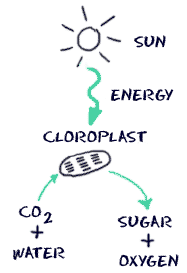The trees, shrubs and herbaceous plants that lose their leaves every year are responding to the short day-lengths of fall. These plants can also be called short-day or long-night plants. As the day length shortens in the fall, chemical reactions in the plants cause the chloroplasts
 in the leaves to stop making chlorophyll. Chloroplasts are the parts of a plant cell that turn sunlight, water and carbon dioxide into sugars that eventually end up in us as cookies, cakes, rice, potatoes, etc.
in the leaves to stop making chlorophyll. Chloroplasts are the parts of a plant cell that turn sunlight, water and carbon dioxide into sugars that eventually end up in us as cookies, cakes, rice, potatoes, etc. Did you know that the only organisms on the earth that MAKE sugar are plants and some bacteria????
Did you know that the only organisms on the earth that MAKE sugar are plants and some bacteria????These chemical responses to the reduction of day length tell the chloroplasts to stop making chlorophyll, so the chloroplasts begin to lose their green color. Once chlorophyll production is stopped, the other colors in the leaves can be seen. Since there is so much chlorophyll being made all of the time during the growing season, the other colors in the trees are masked by all of the green. I won't go into the reason for the green color except to say that it has to do with wavelengths and their reaction to sunlight.
Carotenoids and anthocyanins are two other chemical compounds found in the plant leaf. Anthocyanins show as a red color and are not produced in the leaf until the fall when the chloroplast has stopped production of the chlorophyll. Anthocyanins are produced due to excess sugars in the leaf and the bright lights of fall days. This is why in some fall seasons the trees have brighter red colors than other seasons. Summers with good rainfall and fall days that are warm and sunny with nights that are cool and crisp lead to great red colors in the leaves. This combination allows the production of large amounts of sugar during those warm days but the expulsion of the sugars from the leaves is hindered by the closing of the leaf veins due to the cool nights. This allows the anthocyanin tints of red and purples to "shine" as the green of the chlorophyll recedes.
Anthocyanins are the chemical compounds that color the fruit of blueberries and cherries and numerous other fruits and vegetables. One thing that these fruits and vegetables have in common is their antioxidant properties, which is important because of their free radical scavenging abilities. This is one of the reasons that blueberries are considered a 'super food'!
Another set of chemical compounds that come to light as the chlorophyll recedes are the carotenoids. Carotenoids do two jobs in the plant cell, they bring in light energy for the chlorophyll reaction and they protect the resulting chlorophyll from 'sunburn'. Carotenoids are the chemical compounds that give carrots their orange color and are a precursor to Vitamin A in humans. Since carotenoids are always in the plant cell, the yellow and orange colors that they produce are always the same each fall as they are not dependent on weather conditions.
All of this 'stuff' that is happening every fall are the first signs that the trees, shrubs and herbaceous plants are beginning to shut down for the winter. This protects the plants from the harsh winters and allows them to reappear in the spring.
SO...the next time you are out there 'leaf peeping', think a little bit about what that tree is doing to make these beautiful colors. As I watch the trees and shrubs turn color in my own yard, I can 'see' this wondrous process going on in my mind's eye and I am, once again, in awe of this stupendous natural world around us! Another reason to "Go Green" and protect the earth!



No comments:
Post a Comment